We had two different friends push us to go see Mesa Verde National Park in Southwest Colorado. The park is filled with ancient ruins of early Native American dwellings, many of them built into the edges of cliffs. It’s just an hour west of Durango, where we were headed to visit my sister-in-law, so we decided to stop there for the night.
We got there in the late afternoon, and there were no hook-up sites available, but we were fine for the night in a nice grassy, hilly area with lots of deer wandering through. Our windshield framed a view of a pyramid-shaped mountain.
We took off right away in the car to see what we could see. It’s a good 30-40 minute drive to the museum and/or relic sites, up and over mountains with full views of the valley below, and we saw a herd of wild horses grazing on a steep hill.
By the time we got to the one cliff dwelling site that you can walk down to (Spruce Tree House), it was about ready to close. So we came back early the next morning. It’s surprising the park lets you tromp around these ancient ruins. The cliff dwellings were built from stone and mud sometime in the 1200s. Many of the walls have crumbled away, but so much is still left. Walking through the place these villagers called home 900 years was quieting. To see the smoke left by their fires on the overhang above. To climb up stairs and footholds people, all those centuries ago, had carefully placed or carved. To imagine a thriving community, working together to protect each other and to survive. This place preceded Machu Picchu. In Europe, knights were battling each other in the Middle Ages.
We drove around the park and studied ruins of several mesa-top farming villages. Again, much had been swallowed up by time, but there were foundations of “pit houses” dug into the earth, as well as walls of larger multi-family units. Every village had at least one “kiva,” which is a circular underground room. It is assumed that it was used for socializing and praying. The symbol of circles was important to these people spiritually.
The other cliff villages can only be seen with a tour guide, and this early in the season, only one of the tours was open: Balcony House. This is considered the most physically challenging tour, because it involves climbing 12-foot ladders, using footholds to scramble up rock sides, squeezing through narrow passages, and crawling on hands and knees through a tunnel. Kate wasn’t sure she was up for it, being both afraid of heights and somewhat claustrophobic. But people we talked to said it wasn’t that bad, and she really wanted to see it, so we both bought tickets.
It’s only $4 for the tour and the tours run every hour, but when we got there at 8:30, the tours were sold out until noon. So we went to the museum and watched a short movie and visited other sites. It was noon in no time.
When I’d bought the tickets, the seller remarked to another ranger, “Oh, Clyde’s doing that tour!” in a way that was significant. Good or bad, I wasn’t sure. But meeting him, I knew right away we were the lucky ones. He’s an older Native American ranger, immaculately dressed and with a handsome face. He seemed rather stern at first. Impressing on us the dangers of the obstacle course ahead, and insisting that people who might balk at it ditch the tour now. He barked at people to walk faster, and he pushed us through the scary parts with no sympathy for the ones who hesitated. But when he gathered us around him and told stories, he had us spellbound. He talked us through imagining this life here on the cliffside. What would we do, thrown into this life? How would we survive? What would we make clothes from? What would we eat? How would we carry water? And he involved the youngest person in our group, a college girl, to relay a Native American tale of the story of life and to talk about spirituality and community.
By the 1300s, people living here were gone. They might have migrated to another area, joining the ancestors of other tribes such as the Hopis. Or they may have been wiped out by disease, flood, or famine. The dwellings stayed empty until they were discovered by explorers in the 1800s and a major effort was made to restore them.
I loved being able to scurry up steep ladders and scrabble up rocks, letting my body as well as my mind imagine what it was like to live here. But I also loved the how Clyde guided our imaginations with his words, generating respect and admiration for these people. It was a fully enjoyable experience, and Kate did superbly, climbing up ladders and crawling through tunnels without issue.
On the tour with us was an interesting older couple from Belgium. They drove up in a homemade camper built on a European Land Rover truck base. On the back was a rough map drawing of the world, showing their path. They’d had the vehicle shipped from France to Africa, where he worked for a time. And then on to South America. They had been traveling in South and Central America for the last two years, and they were just starting to explore the states. They were a little bit shy, not used to boasting about their travels in the way that Americans do. But he was proud of the camper shell he built and showed us on the back all the places they have taken it.
We were meeting my sister-in-law for dinner in Durango, so we hightailed it out of there after the tour. It was a quick stop in Mesa Verde, but we packed in a lot and left feeling satisfied that we’d really gotten to experience it.

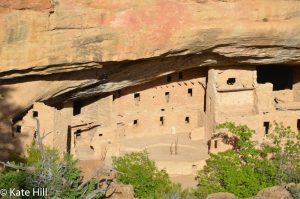
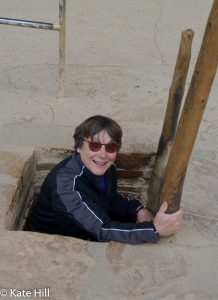
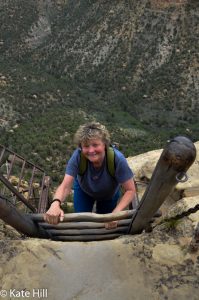
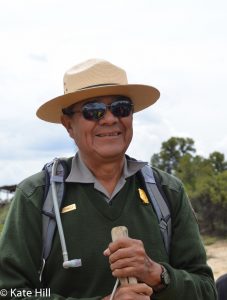
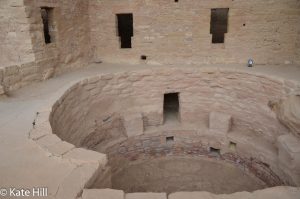
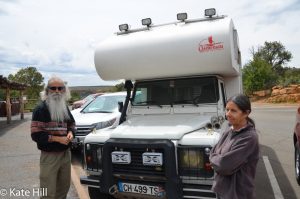
I’ve always loved this spot from the time we went there on a family camping trip when I was nine. Loved your descriptions and meeting Clyde virtually. Sounds like you lucked out!
Another for my list! I loved imagining the cliff dwelling with all the reminders of the past. But I equally loved hearing about the people you met. Places and People… my favorite kind of travel!
I finally got to read this post—so glad the two of you got to Mesa Verde and both made that tour with a great guide. It was my most favorite spot from the time I was traveling around the country in my late twenties. Such a special place!